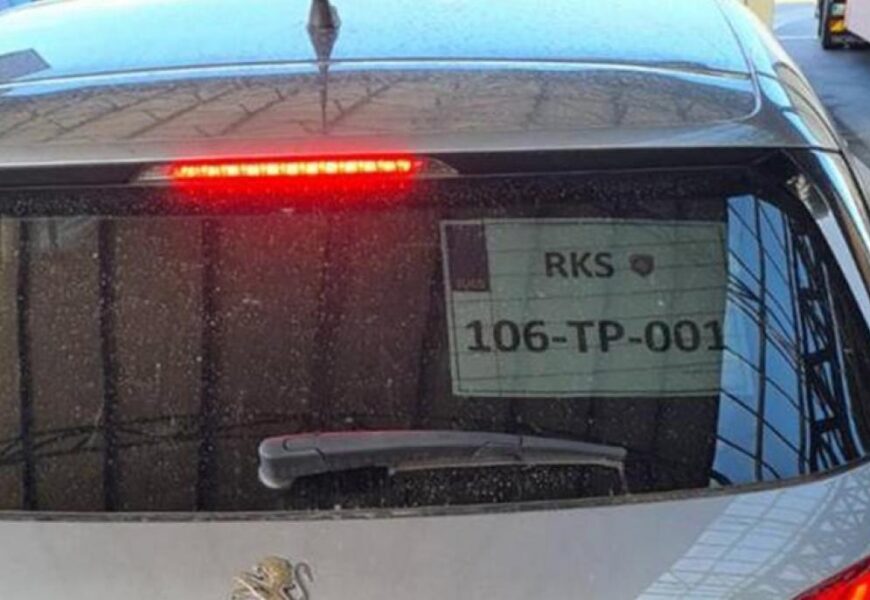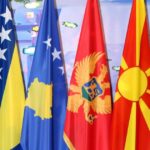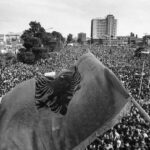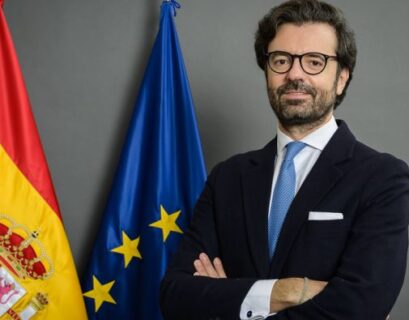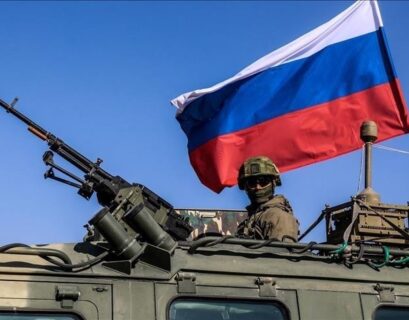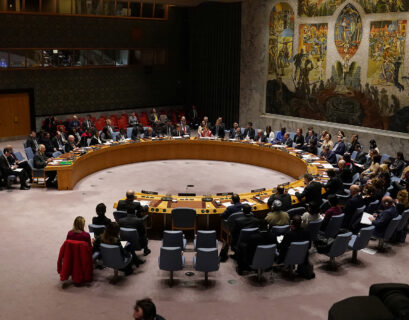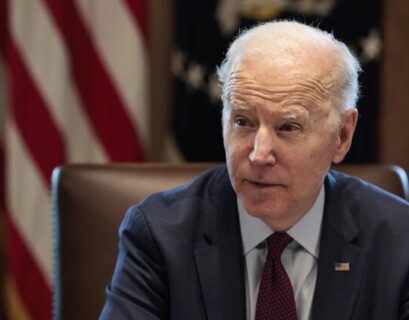By Sylë Ukshini
The Prime Minister of Kosovo, Albin Kurti, had warned that the license plate agreement had not been fulfilled by Belgrade and that the Serbian leadership was not offering a solution after the settled deadline. On the other hand, for years, Belgrade enforced a removal policy for every license plate from Kosovo with the inscription “RKS” and actively replaced them with “Proba” license plates designed with Serbian state inscriptions and symbols. As a result, the Government of Kosovo was compelled in adopting a similar stance against vehicles with Serbian license plates entering Kosovo borders. Although these actions were in line with the agreement reached in Brussels between Pristina and Belgrade in 2011, it prompted a theatrical reaction of the Serbian authorities. As has occurred often throughout the past decade, Belgrade assumed a defensive approach. It again used local Serbs in northern Kosovo to set up barricades and organize “spontaneous protests” by “frightened” citizens to hinder the implementation of the license plate agreement. It was a typical spectacle we have seen in the former Yugoslavia dating from 1988, when Milosevic launched the so-called “anti-bureaucratic revolution”, which resulted in the violent dissolution of a multinational Yugoslavia.
Brussels reacted powerlessly, repeatedly calling for de-escalation of the situation in the north, but did not explicitly request that Belgrade respect the agreement signed in 2016. Therefore, despite the “spontaneous protests” of “frightened” Serbian citizens, the Kosovo police (ROSU) had not intervened in any populated area, but rather stayed at the border crossings in Bernjak and Jarinje to enforce the agreement. It was the “frightened” Serbs who were obstructing the movement between Kosovo and Belgrade, blocking the roads leading to these two border crossing points with the neighboring state by using heavy vehicles. Belgrade contended that Kosovo was aggravating the situation, while members of the Serbian opposition openly stated that Kosovo’s initiative was in line with the Brussels agreement of 2011, which stated that “all car owners residing in Kosovo will use RKS or KS license plates, issued by the responsible authorities in Kosovo” (Point 7 of the Brussels agreement).
When Kosovo’s leadership agreed to extend the validity of KS license plates for another five years, until September 14, 2021, it was clear that the government was acting in accordance with the Brussels Agreement, which was finalized on September 14, 2016. Kosovo had announced the imposition of a reciprocity measure on license plates with Belgrade. “I wrote a letter to all European governments listing the 11 violations that Serbia is committing with the imposition of systematic and periodic barriers. I am expecting differently and reciprocity shall be imposed as the only way . There is no equality without reciprocity”, declared the Prime Minister Albin Kurti, after the last meeting in Tirana with the German Chancellor Angela Merkel. On the other hand, one cannot ignore the significance of US Deputy Assistant Secretary of State for European and Eurasian Affairs, Gabriel Escobar’s statement that upheld Kosovo’s right to impose reciprocity. However, his statement indicated that Washington was surprised by the way this decision was implemented.
Consequently, the measure of reciprocity against Serbian license plates arose because the citizens of Kosovo, who would cross the border with vehicles bearing RKS license plates, were forced to remove the latter and replace them with the Serbian “Proba” plates. As these measures were becoming a burden for both countries, Kurti had stated that Kosovo was “willing to remove the measure of reciprocity with Serbia concerning license plates, if Belgrade will do the same for license plates of vehicles from Kosovo”. The response of the Serbian President was aggressive and theatrical. Police, military troops, aircraft carriers and helicopters were sent to the border with Kosovo in an effort to test NATO’s resolve. Unlike Vucic, Milosevic never took such a confrontational step, let alone make the blunder made by the current Serbian government – issuing threats through inspections of military troops at the border by the Russian ambassador in Belgrade. Is becomes evident that the safety of the “people” was at stake by the Serbian military measures and not by the application of reciprocity on license plates. During the last EU-Western Balkans summit, held on October 6 in Brdo, Slovenia, Kosovo Prime Minister Albin Kurti called on EU leaders to condemn “the engagement of the Serbian army on the Kosovo border.”
Opposition reaction
Regarding events in northern Kosovo, all parliamentary political parties in Kosovo supported Kurti in applying the reciprocity measure for license plates, with very few opposing the decision. Moreover, they called on Pristina to continue with other measures of reciprocity. At the same time, the behavior of the Serb List MPs was criticized, who supported the criminal structures and violent groups in the north which had blocked roads and constantly provoked the Kosovo police. It was clear that the Government of Kosovo had the full support of the entire political spectrum, although in the meantime there were accusations that this measure of reciprocity was being used by the ruling party for electoral purposes.
Agreement of September 30
At this point, the priority for the international community was to reduce tensions among the two and reach an agreement. Vucic’s threats for war forced the EU and the U.S. to respond. The arrival of KFOR was the moment it became clear that there would be no conflict and that everything had to be resolved through active negotiations. Despite setting conditions in advance, Belgrade was forced to go to Brussels. After two days of intensive negotiations in Brussels, Pristina and Belgrade reached an agreement that would de-escalate the situation in the north, which provided for the simultaneous removal “of the special unit of the Kosovo Police located in Jarinje and Brnjak, and the roadblocks until October 2 ”. Meanwhile, working groups will be formed between Kosovo, Brussels and Belgrade in order to reach “a permanent solution to the issue of license plates based on EU standards and practices”.
Point 2 of the agreement stipulated that as of October 4, stickers would effectively be placed on the license plates of vehicles entering from Serbia to Kosovo and vice versa, to cover state symbols. Looking back, the license plate agreement demonstrates that the current dialogue in Brussels between Kosovo and Belgrade, which began in the spring of 2011, has not led to the normalization of neighborly relations and that the EU has proven to be unsuccessful in reaching a comprehensive agreement. Consequently, after ten years of negotiations it is not appeasing to see how EU continues to deal with the issue of license plates, electricity bills and other technical issues.
Certain points under this agreement sound ambiguous; for example, the deployment of KFOR troops at multiple border points, which implies a step backwards and risk that this presence of only 12 days, will prove be longer. This, as result of Belgrade’s obstruction, which can again mobilize the “frightened people” in case ROSU units are dispatched to this part of Kosovo. In this regard, the wording of point 1 of the agreement was seen as problematic, according to which a sort of equalization is made between the police and the demonstrators, among whom there were also leaders with criminal precedents. This first point stipulates that there should be a simultaneous withdrawal of “Special forces and barricades set up by Serb protesters”. At the same time, the EU should not fall into Belgrade’s trap, claiming that there is an agreement not to send ROSU units to the north of the country. This intention of Belgrade is targeted at the legalization of the factual annexation of the country before reaching a comprehensive agreement. Even more problematic and slightly unclear is the issue of license plates issued by Belgrade containing sticker designs that pertain to cities in Kosovo, such as PR (Pristina), GL (Gjilan) KM (Mitrovica), which will be valid until April 2022. It remains to be seen whether Belgrade will try to prolong the temporary solution with such license plates, as occurred when Kosovo was under Belgrade’s interim administration or whether both sides will come to a more effective solution.
Soon after the announcement of the agreement, Prime Minister Kurti stated that Belgrade should get accustomed to reciprocity, while the Serbian president stated that the stickers were their idea. If this was the case, why were they not applied before? Apparently, Belgrade seems to be happy about the conclusion of agreement which avoids carrying of RKS license plates by Serbs entering Kosovo and by local Serbs. At the same time, the extent of this agreement’s implementation by the Serbian side, remains to be seen. From day one, there were information that a number of cars in the north of the country were seen in traffic with Serbian license plates uncovered with stickers, as required by the second point of the license plate agreement.
The Government of Kosovo must be cautious and not allow the prolongation and persistence of these illegal license plates with the inscriptions of the cities of Kosovo, because they are beyond any national, or international norms. It would be inconceivable for license plates issued by the Czech Republic to apply to the cities of Slovakia or those of France, or any other country. On the other hand, Belgrade has made it very clear that it intends to paralyze the functionality of the state of Kosovo through the creation of an autonomous Serbian entity with state powers. If in 1999, the West engaged in a military intervention against Belgrade to prevent the recurrence of another Bosnia, it is just as immediate now that a Second Bosnia is not experimented in Kosovo. In such a situation, perhaps the ones most affected would be the local Serbs in Kosovo, who are exploited by Belgrade for political purposes, and even blackmailed by criminal groups. Consequently, both in Belgrade and in the EU, it was confirmed that Belgrade was the main player in setting and removing the blockades in the north. It is a typical situation in both Croatia and Bosnia, when the West negotiated with Milosevic to end the Serbian armed rebellion in these new states. Also, the license plate event showcased that regional cooperation, pompously promoted through the so-called “Open Balkan” initiative, cannot be strengthened without treating Kosovo as an equal regional player and without the normalization of Kosovo-Serbian relations. In this sense, it is clear that all avenues of regional cooperation pass through Kosovo. Despite this, the Serbian leadership in Belgrade has so far shown no serious effort to reach an agreement. The Serbian side also refused to sign the proposal of the Kosovo side to sign the Declaration of Peace for non-aggression.
International response
Finally, the EU, U.S., and NATO last week reacted with a sense of urgency to avoid the escalation of conflict. KFOR also sent troops on the ground in response to Serbian military provocations. This engagement and especially, the U.S.-EU cooperation led to the finalization of the license plate agreement. In a speech to MEPs, The High Representative of the European Union for Foreign Affairs and Security Policy, highlighted the role of U.S. diplomat Gabriel Escobar in resolving the impasse in north of Kosovo. As is the diplomatic custom for the agreements reached between the parties to be supported by the decision-making centers, the license plate agreement has been described as a great success in Brussels, Berlin, Washington and NATO. In this sense, there is a great emphasis on the fact that the continuation of the dialogue remains the only way forward.
The need to accelerate dialogue
Belgrade’s strategy is clear – namely to negotiate indefinitely, make agreements, but not to implement them, in order to then renegotiate in order to reach new concessions on old agreements. Instead of making progress on the license plates, Belgrade will try to foster the issue of forming the association of Serbian municipalities until the end of this year, with the aim of obtaining new concessions for the Serbian Orthodox Church and other sectors in the final agreement. Therefore, substantial progress on the issue of a comprehensive agreement is not expected until the Serbian parliamentary elections in April 2022. Meanwhile, the EU will have to deal with the issue of the energy agreement, which has not yet been fulfilled by the Serbian government. Consequently, The Government of Kosovo, even after 22 years from the war, continues to pay for the electricity consumed by local Serbs. Obviously, the U.S. and Germany had the main say in this regard, with Brussels taking a step back.
So far, the developments have made it clear that the results of the dialogue during these ten years have been modest. The latest agreement on the plates, which once again revealed the crucial role of the U.S., made the substantial involvement of the U.S. inevitable. Especially in light of the fact that the EU special envoy, former Slovak Foreign Minister Miroslav Lajcak, failed in achieving any sense of comprehensive normalization. In this context, we also ought to see the letter of U.S. Congressmen Torres and others to President Biden and Secretary Blinken in October, in which they demand that “the American focus on resolving Kosovo-Serbia tensions be doubled”, calling on the U.S. to stand by Kosovo as an American ally “,
This tense situation among Kosovo and Serbia is an outcome of Belgrade’s efforts to carry out their idea of a “Serbian World”. This political propaganda has been proclaimed by the Serbian state leadership for some time now, takes the region back to the horrendous violence of the past century. It is precisely this approach that has hindered the progress of the Brussels dialogue and the normalization of Kosovo-Serbian relations. Moreover, the tension ignited over the reciprocity of the license plates demonstrated the minimal amount of progress in political relations since the Brussels dialogue began in 2011. The Brussels dialogue has shown that it has reached its limits. Therefore, now is the right time for a new approach, for a dialogue reset, which would imply that the EU would give up its “status-neutral stance” and do more for the recognition of Kosovo by the five EU countries that yet to recognize it, and at the same time, the stronger involvement of the US in reaching a final agreement on comprehensive normalization.
In this line the EU should be more concerned with the five EU member states—Spain, Slovakia, Cyprus, Romania, and Greece—that still have not recognized Kosovo’s independence. These European countries stated their respect for international law as their reasons for this lack of recognition. Considering their respect for international law, these countries should also accept the International Court of Justice’s 2010 decision proclaiming Kosovo’s 2008 declaration of independence legal and sui generis.
At the same time, in the context of the European integration of the Western Balkan region, the EU should build a symmetrical approach and refer to them as the Western Balkans Six, because we are dealing with six independent states. Otherwise, the longer this dialogue continues as is, the more counterproductive it will become in nature, and every aspect of the talks will be reduced to separate and endless agreements, which would propel the normalization of interstate relations between Kosovo and Belgrade farther into the distant future.
PhD. Sylë Ukshini is a diplomat, historian, scholar of international studies and international law.


